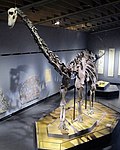Zoologisk museum | |
 The museum the day before its final closure in 2022 (will reopen in 2025 at a separate location) | |
 | |
| Established | 1862 |
|---|---|
| Location | Universitetsparken 15, 2100 Copenhagen, Denmark |
| Type | Natural history museum |
| Director | Peter C. Kjærgaard |
| Website | http://zoologi.snm.ku.dk |
The Copenhagen Zoological Museum (Danish: Zoologisk Museum) was a separate zoological museum in Copenhagen, Denmark. It is now a part of the Natural History Museum of Denmark, which is affiliated with the University of Copenhagen. The separate museum location closed in 2022, but will reopen in 2025 (as part of the combined Natural History Museum) in new and considerably larger buildings in the northeastern corner of the Copenhagen Botanical Garden. Although the museum will be relocated, the research and storage facilities at its old location have been maintained. [1]








